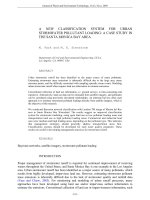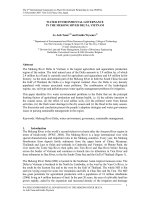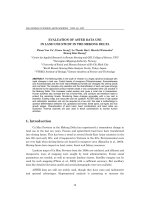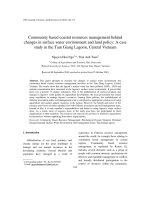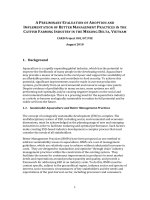Returns to education a case study in the mekong delta vietnam
Bạn đang xem bản rút gọn của tài liệu. Xem và tải ngay bản đầy đủ của tài liệu tại đây (458.26 KB, 140 trang )
THE UNIVERSITY OF ECONOMICS
HO CHI MINH CITY
VIETNAM
THE VIETNAM-NETHERLANDS PROJECT FOR MA
PROGRAM IN DEVELOPMENT ECONOMICS
RETURNS TO EDUCATION A CASE STUDY IN
THE MEKONG DELTA - VIETNAM
By
TRAN NAM QUOC
IN PARTIAL FULFILLMENT OF THE REQUIREMENTS FOR THE
DEGREE OF MASTER 0F ARTS IN DEVELOPMENT ECONOMICS
SUPERVISOR: Prof. NGUYEN TRONG HOAI
HO CHI MINH CITY, DECEMBER 2009
RETURNS TO EDUCATION: A CASE STUDY IN THE
MEKONG DELTA- VIETNAM
By
TRAN NAM QUOC
SUPERVISOR: Prof. NGUYEN TRONG HOAI
HO CHI MINH CITY, DECEMBER 2009
CERTIFICATION
I certify that the substance of this study has not already been submitted for
any degree and is not being currently submitted for any other degree.
I certify that to the best of my knowledge, any help receiving in preparing this
thesis, and all sources used, have been acknowledged in this thesis.
Ho Chi Minh City, December 2009
TRAN NAM QUOC
ACKNOWLEDGEMENTS
The thesis, titled "Returns to Education: A case study in the Mekong DeltaVietnam", is a fulfilled research of Vietnam Netherlands Program (VNP). This thesis is
the quantitative analysis mainly based on data from the VHLSS 2004 and VHLSS 2006
which surveyed by General Statistical Office (GSO). In order to have an
accomplishment of this research, the author had received a lot of precious supports from
professors and office staffs ofVNP.
Firstly, the author would like to express special thanks to Prof. Nguyen Trong
Hoai, the author's supervisor, who advised many scientific instructions in during
process to conduct the thesis. Particularly, thanks to these worthy instructions and
kindly help from Professor, the author completed the research and released
scientifically convincible results.
I would like to thank Prof. Karel Jansen, for worthy comments on Thesis
Research Design (TRD) formation of this thesis.
I would like to express sincere thanks to Dr. Nguyen Huu Dung who has
provided valuable comments for completion of this thesis.
I would like to thank sincerely Mr. Truong Thanh Vu, the visiting lecturer of
VNP, for valuable comments and instructions in filtering the appropriate data set.
I am indebted to all teachers and staffs of the Vietnam - Netherlands Program
at University of Economics HCM.
Finally, I am indebted to my family and others who gtve me great
encouragement and support for my study.
11
ABSTRACT
The purpose of this research is to examine the return to education in Mekong
Delta. The author has applied descriptive statistics, econometric model to examine
return to education classified by return to schooling (RTS) and rate of return to
education (RORE) within each different level of education. The return to education
is also investigated separately for each of controlling variables in sub-groups. The
data sources are selected from VHLSS 2004 and VHLSS 2006 ofGSO.
This study found out meaningful findings. Firstly, on average, RTS is
increased overtime. Thus, it increased from 3.46 percent in 2004 to 4.13 percent in
2006. RTS is higher for female than for male and higher for persons living in urban
than those living in rural, at 7.45 percent and 3.26 percent, respectively. It is also
higher for individuals working in service sector and industry-construction compared
to whose working in agriculture-forestry sector. Secondly, RORE at high - school
level is highest, at 11.49 percent" in 2004 and 11.89 percent in 2006. In addition,
RORE of workers working in public sector is higher compared to private sector at all
below education levels; however, RORE of individuals with university and working
in private sector is 14.19 percent, higher than those in public sector (8.29 percent).
Finally, in particular, RORE of workers with university and working in industryconstruction sector obtained highest rate, at 24.81 percent in 2006.
This study also argued mainly significant policy implications. Firstly, the
policies attracting high educated labor force to work in rural areas are worth to be
considered. Secondly, the process of rural urbanization should be strengthened more
quickly to develop private sector and create more employment in rural areas. Thirdly,
high school, college and university education should be prioritized and more
improved to increase more high-skilled labor force serving for economic
development strategy in this region. Favorable conditions and subsidies to make
more opportunities for women increasing enrollment should be more considered.
Finally, advocacy programs should be strengthened for all organizations, families
and individuals to change their perceptions and share roles and responsibilities for
education and human development.
111
CONTENTS
Certification.................................................................................................................................................. i
Acknowledgements................................................................................................................................... ii
Abstract....................................................................................................................................................... iii
Content table.............................................................................................................................................. iv
List of Tables........................................................................................................................................... viii
List of Figures........................................................................................................................................... ix
List of Abbreviations............................................................................................................................... x
CHAPTER 1: INTRODUCTION
1.1
Introduction...................................................................................................................................... !
1.2
Research objectives....................................................................................................................... 3
1.3
Research hypotheses..................................................................................................................... 4
1.4
Research methodology................................................................................................................. 4
1.5
Data..................................................................................................................................................... 5
1.6
Thesis structure............................................................................................................................... 5
CHAPTER 2: LITERATURE REVIEW........................................................................................ 6
2.1.
Theoretical background.............................................................................................................. 6
2.1.1 Economics of education............................................................................................................. 6
2.1.2 Human capital theory.................................................................................................................. 7
-
2.1.3 Education and economic development.............................................................................. 10
2.2. Theoretical methods and conceptual models...................................................................... 12
2.2.1 Theoretical methods................................................................................................................... 12
2.2.1.1 Cost Benefit Analysis methods............................................................................................ 12
2.2.1.2 The Short-cut method.............................................................................................................. 13
IV
2.2.1.3 The Reverse Cost- Benefit method ................................................................
2.2.1.4 The Earning function methods
2.2.2 Conceptual models ............................................................................................
2.2.2.1 Utility function .................................................................................................
2.2.2.2 Mincerian model ............
2.2.2.3 Other conceptual models
2.3. Empirical approaches with determinants of rate of return to education .............
2.3 .1 Empirical models ................................................................................................
2.3 .2 Empirical evidences ............................................................................................
2.3.2.1 Schooling year and education level .................................................................
2.3.2.2 Experience .......................................................................................................
2.3.2.3 Gender ..............................................................................................................
2.3 .2.4 Household characteristics ...............................................................................
2.3.2.5 Private and public sector ..................................................................................
2.3 .2.6 Rural and urban area ........................................................................................
2.3.2.7 Agricultural and Non- Agricultural sector .....................................................
2.3.2.8 Ethnic group .....................................................................................................
2.4 Chapter summary ................................
CHAPTER 3: RESEARCH METHODOLOGY ....................................................
3 .1 Key concepts .........................................................................................................
3.. 2 Model specification ...............................................................................................
v
3.3 Identification bias ability of missing an innate variable....................................................... 35
3.4 Data set and variable measurement............................................................................................. 36
3.5 Steps to estimate parameters in regression models................................................................. 38
3.6 Chapter summary.............................................................................................................................. 39
CHAPTER 4: RESEARCH CONTEXT: THE MEKONG DELTA
OVERVIEW............................................................................................................................................. 40
4.1 Geographic........................................................................................................................................... 40
4.2 Demographics..................................................................................................................................... 41
4.3 Education and Earning in Mekong Delta................................................................................... 41
4.3.1 Enrolment in general education................................................................................................. 42
4.3.2 The important role of primary.................................................................................................... 42
4.3.3 Vocational and tertiary education.............................................................................................. 43
4.4 Regional and Sector.......................................................................................................................... 44
4.5 Human resource development of the region............................................................................. 45
4.6 Distribution of education attainment as a policy tools........................................................... 46
CHAPTER 5: EDUCATION AND RETURNS TO EDUCATION IN
THE MEKONG DELTA...................................................................................................................... 47
5.1 Education - human capital and earnings of workers in the Mekong Delta ......................4 7
5 .1.1 Education and human capital.................................................................................................... 4 7
5 .1.1.1 Educational level structure..................................................................................................... 4 7
5 .1.1.2 Labor structure classified by sectors................................................................................... 48
5 .1.1.3 Schooling year classified by gender and region characteristics ................................. 49
5 .1.1.4 Schooling year classified by sectors.................................................................................... 50
5 .1.2 Earnings of workers..................................................................................................................... 51
5.1.2.1 Per capita income classified by gender and regions........................................................ 51
Vl
5.1.2.2 Per capital income classified by sectors ..........................................................
5.1.2.3 Per capita income classified by education levels ............................................
5.2 Empirical findings ..................................................................................................
5.2.1 Examine the effect of parental education on RTS of workers ............................
5.2.2 Estimation ofRTS in 2004 and 2006, Modell .................................................
5.2.3 Estimation ofRTS in 2004 and 2006 associated with Sub-group variables,
Modell .......................................................................................................................
5.2.4 Estimation ofRORE within each education level in 2004 and 2006, Model2 ..
5.2.5 Calculation RORE within each education level for sub- group variables in
2006, Model 2 .............................................................................................................
5.3 Charter remarks ......................................................................................................
CHAPTER 6: CONCLUSION AND POLICY IMPLICATION ..........................
6.1 Conclusion ................................
6.2 Policy implications ................................................................................................
6.2.1 Economic policy .................................................................................................
6.2.2 Education policy .................................................................................................
LIMITATION OF THE RESEARCH .....................................................................
SUGGESSION FOR FURTHER RESEARCH ....................................................
REFERENCES
APPENDICES
Vll
LIST OF TABLES
Table 2.1: Return to education in the world ...............................
Table 3.1: Definitions and notations of model variables .............................................
Table 4.1: Gini coefficients in the Mekong Delta····································'·················· 46
Table 5.1: Mean of schooling year classified by gender and region characteristics ...
Table 5.2: Mean of schooling year classified by sectors .............................................
Table 5.3: RTS for workers having parental education (2006) ..................................
Table 5.4: Estimation results of Modell ..........................................
Table 5.5: RTS associated with Sub-group variables, Modell ..................................
Table 5.6: Estimation results ofModel2 .....................................................................
Table 5.7: RORE for each education level ..................................................................
Table 5.8: Estimation results for sub- group variables, Model2 ................................
Table 5.9: RORE within each education level.. ........................................................... 60
vm
LIST OF FIGURES
Figure 2.1: Human capital: conceptual schema of an individual........................................... 9
Figure 2.2: Intellectual capital: conceptual schema of a company......................................... 10
Figure 2.3: Research schema of earnings functions and growth models from the
human capital point of view.................................................................................................................. 11
Figure 2.4: Stylized Age-Earnings Profile....................................................................................... 13
Figure 4.1: The geographic of the Mekong Delta........................................................................ 40
Figure 5.1: The structure of education level in the MKD in 2004 and 2006.....................48
Figure 5.2: The labor structure classified by sectors................................................................... 48
Figure 5.3: Means of per capita income classified by gender and regions......................... 51
Figure 5.4: Means of per capital income classified by sectors................................................ 52
Figure 5.5: Means of per capita income classified by education levels ............................... 53
lX
LIST OF ABBREVIATIONS
AUSAID
: Australia Aid Program
GSO
: General Statistical Office
MDEC
: Mekong Delta Economic Cooperation
MKD
: Mekong Delta
IV
:Instrument Variable
OJT
: On-the-Job Training
OLS
: Ordinary Least Square
PPA
: Participatory Poverty Assessment
RORE
: Rate of return to Education
RTE
: Return to Education
RTS
:Return to Schooling
UNDP
:United Nations Development Program
VHLSS
:VietNam Household Living Standards Survey
VND
: Vietnam Dong
2SLS
: Two- Stage Least Square
X
CHAPTER 1: INTRODUCTION
1.1 Introduction
Nowadays, the developing of knowledge - economic as well as emerging
technologically - centered economic system calls for the acquisition and mastery of
new knowledge, or for the upgrading of skills. Therefore, the need for human capital
development and accumulation is a priority condition for modem economic growth.
Human capital, which is normally known as the skills and knowledge intensity of the
labor force in an economy, is essentially acquired through schooling and training.
According to Olaniyan and Okemakinde (2008), the improvement in education has
been a significant explanatory variable for East Asian economic growth. In fact, East
Asian countries are not abundant and rich in physical capital as well as natural
resources. However, they have gained great achievement in economic growth due to
appropriate policies, particularly, the rational investment strategy for education to
develop human capital.
On the national view, that education increases productivity and income of
workers is a good argument to persuade the governments investing more in
education. Moreover, education investment by public and private are driven by the
rate of return considered as the benefit of education in the labor market. The nature
of labor market may be understood by investigating return to education in association
with gender, by region at a time, and its changes overtime. This will help to develop
the strategies and policies for investment education more appropriately (Duraisamy,
2000).
It is becoming clearly to policy makers that education is a key factor in the
poverty reduction. Schooling is integral to this approach as it enhances the
adaptability and efficiency of workers. The return to education plays a crucial role in
determination of educational attainment, participation and ultigmtely on earning
received by workers in the labor market. It also influences the regionally human
resource allocation (Sackey, 2008; Psacharopolous and Patrinos, 2002). Therefore,
studying on returns to education is crucial to guide macro-policy decisions relating to
the organization and financing of education reforms.
1
For the case of Vietnam, the Constitution of the Socialist Republic of Vietnam
1992, the Education Law 1998, the Political Report at IXth Congress of the Vietnam
Communist Party 2001 and the socio-economic strategic plan for 2001 - 20 10 have
identified guiding view-points for the educational development that "Education is the
foremost national policy". Vietnamese Communist Party stated that "In 21st century,
the revolution of science and technology will continue to be developed, changing the
society from era of industry to the era of information and knowledge based economy,
at the same time affecting all fields of human activities, changing rapidly the physical
and spirituals life of society. The distance between scientific-technological inventions
and their applications in practice is gradually reduced. The knowledge treasure of
mankind is becoming diversified, abundant and increasing by geometric progression"
Furthermore, rapid progress of science, technology as well as dynamic
development of economies in quickly integration and globalization have been
creating opportunities that may help to reduce the gaps among countries. Science and
technology are becoming the main driving force for socio-economic development. In
this context, education is the foundation of science-technology development and
human capital development to satisfy the requirements of a modem society. It plays
the key role in enhancing national awareness for the capability and responsibilities of
the present as well as future generations. Then, investment in education is considered
as investment for development rather than for social welfare as before (the National
Assembly of Vietnam 1992, 1998; the Vietnamese Communist Party 2001; and the
MOET 2001 ).
Moreover, education is also one of the important driving forces to accelerate
the industrialization and modernization process. Thus, the key for long-term
sustainable growth in the new emerging economy is the contribution of knowledge
to output growth. Therefore, firstly, the creation of indigenous knowledge through
human capital development is the key component to maintain competitiveness.
Secondly, participation in WTO requires that Vietnam has to enhance education to
develop human capital serving for global integration process. Finally, education
2
development is a key factor for long-term strategy of economic growth and social
equality.
In addition, according to PPA in Mekong Delta 2003 (UNDP and AUSAID,
2003 ), Mekong Delta is among the poorest regions in Vietnam. Enrolment rates
(VHLSS 2001- 02) indicated that the Mekong Delta had continued to have lower
enrollment rates in comparison to the nation as a whole. The enrolment rates· in
primary, lower secondary and upper secondary are 88.8, 59.5 and 29.3 percent
compared to 93.1, 71.2 and 42.1 percent as a whole nation respectively. Furthermore, it
accounts for the highest ratio of poor people in Vietnam and its majority of population
are living in rural areas and working in agriculture.
After The Doimoi since 1986, major economic reforms in Vietnam, as well as in
the Mekong Delta, have posed positive impacts on the labor market, education and the
returns to education as well. Because of lower education level and higher drop-out of
school, the quality of human capital resource in this region is still weak and inadequate
capacity for application and taking advantages of technological progressiveness. It is
clearly that human capital development is a key driver for economic growth, and has
become even more crucial and important in this region. However, the evidence for this
issue is relatively limited; and in recently, study on return to education in Mekong Delta
has not yet been done. Therefore, research on education to enhance capacity of human
capital is necessary and significant for the Mekong Delta. Hence, the Mekong Delta area
is chosen for study in this research. It is expected to examine the overall context and
effect of education, and draw some sound implications for policy makers. This research
concentrates on the topic
"Returns to Education: A case study in the Mekong Delta- Vietnam".
1.2 Research objectives
The aim of the paper Is to examine the situation of human capital and education
development to have meaningful policy implications in the Mekong Delta. In this
research, the basic premise is that education enhances the productivity of a worker,
which is, in tum reflected in his earnings. Mincer - type earning function is adopted to
estimate the rates of return to education. The specific
3
objectives of the study are tailored towards addressing the key research issues raised
above. The specific objectives of this research are to:
(1) Investigate the difference in returns and rates of return to education among
different levels of education, with take into account of effects of gender, sectors, and
regions.
(2)
Examine the effects of parental education on return to education.
1.3 Research hypotheses:
The following hypotheses (H) are of interest in this research:
H 1 : There is a positive impact of schooling years on yearly income per capita in
the Mekong Delta.
H2: Return to education is influenced by parental education.
H3: Return to education has changed overtime.
H4: Return to education of female is higher than that of male.
H5: Return to education of workers in urban is higher than that in rural areas.
H6: Return to education for workers in public sector is higher than that of those
working in private sector.
H7: Return to education for individuals working non-agricultural sector is higher
than that in agricultural sector.
1.4 Research Methodology
To fulfill answer the above objectives and research questions, descriptive
statistics and quantitative methods are applied in the study. Descriptive statistics will
accommodate readers with a general view about educational and human resource
characteristics in the Mekong Delta. The econometric analysis technique,
particularly Multiple Regression Model estimated by OLS and 2SLS is employed to
estimate the parameters and returns to schooling. The theory applied in this research
is based on Human capital theory and the earning function of Mincer, namely,
extended Mincerian model.
4
1.5 Data
The main data for analyses. is drawn from VHLSS 2004, and VHLSS 2006
conducted by GSO supported by UNDP. These data sets are used for many research
goals. Details of the surveys and data information will be described in the
methodology chapter.
1.6 Thesis Structure
The structure of the thesis includes 6 chapters organized as follow: the first is
an introduction chapter, presenting research problem, the need for doing an
investigation of returns to education, research questions, objectives and hypotheses.
The second chapter is for reviewing of literature on theories of human capital and
return to education, theoretical background of return to education studies and
empirical evidences. The third chapter describes research methodology. In chapter 3,
the variables, models and data will be specified in detail. Chapter 4 is to provide an
overview of the research context, and synthesis of main information relating to
human capital and education in the Mekong Delta. Chapter 5 presents analytical
results on returns and rates of return to education. Finally, Chapter 6 is for
conclusion, policy implications, limitations of the research, and suggestions for
future research.
5
CHAPTER 2: LITERATURE REVIEW
This chapter will be presented 3 parts. The first part concentrates on general
theories including economic theories of human capital and education, and aspects on
return to education. The second part investigates theoretical background and
empirical models relating to the return and rates of return to education. The final one
presents empirical evidences on the studies of return to education.
2.1 Theoretical background
2.1.1 Economics of education
Economics of education is a significant issue documented in literature. The
crucial role of education for raising the productive capacity of society was raised by
Adam Smith in The wealth of Nations in 1776. It has been developed continuously
by famous economists like Gary Becker, Jacob Mincer and Theodore Schultz who
conducted major, innovated researches applying economics to education issues.
Education can be defined as all studying forms and specific means. In the
other words, education is referred to activities trained in the place that is named
school. Education is the most important institution to develop human capital in
association to many of the following aspects: "(i) people are demanding education
highly and believe that education benefits them and their children; (ii) education and
earning have a relationship individually as well as socially; (iii) budget for education
accounts for a high ratio in family and national budget" (Torado, 1994). Torado also
said that human capital investment is useful and conducted through investment in
formal education, OJT, and health. It will increase quality of labor force as enhancing
in skills, capacity, ideas and health. Furthermore, it is profitable if discounted profits
are higher than discounted expenditures.
Education makes people knowledge abundant, creates comfortable life, and
generates benefit for individuals and society as a whole. Education also increases
working productivity, management capacity as well as scientific and cultural
progressiveness. The person with higher level of education would gain a higherstarting salary and the steeper the rise in earnings during the early working life.
6
Return to education is crucial information to address the relationship between labor
market earning and education. They are significant not only for the government and
policy makers but also for all people investing in education (World Bank, 1991,
Mock et. al., 1998, and Arcandy et. al., 2004).
In addition, education was regarded as both consumer and capital good
because it offers utilities to consumers and also serves as an input into the production
of other goods and services. In term of capital good, education can be used to
develop the human resources for socio - economic transformation by creating
qualified citizens and upgrading the general standard of living in a society.
Therefore, positive social change is likely to be · associated with appropriate
education (Olaniyan and Okemakinde, 2008). Furthermore, to clarify the relationship
between human capital and education, on human capital aspect, Machin (2007)
indicated that education should be seen primary as an investment good in stead of
consumption good. Individuals invest in human capital, such as schooling, because
human capital makes a person more productive reflected in higher wages in the
future. Therefore, individuals primarily make investments in schooling and other
forms of human capital to earn returns, i.e. to increase their income in the future.
In term of study approach, according to Fleischhauer (2007), economics of
education is divided into two different branches for studying the returns to education.
The micro labor approach investigates returns to education by measuring the extra
earning of a worker for an additional year of schooling and training. Meanwhile, the
macro approach investigates whether the level of education in a cross-section of
countries related to the GDP growth rate. In this study, the aim is to examine private
rate of return to education, so only the micro literature will be focused.
2.1.2 Human capital theory
In the 1950s and 1960s, developed by American economists such as Gary
Becker and Theodore Schultz, human capital refers to knowledge and acquires skills
of a person accumulated. It helps to increase his or her ability to conduct activities
with economic value. Human capital theory has also emphasized that
7
individuals invest in human capital as investors invest in education to earn higher
income in the future.
The fundamental of the human capital theory is the analogy between physical
and human capital that means individuals can invest in human capital by education
and training with an expectation of higher returns in the future. It emphasizes how
education increases the productivity and efficiency of workers by increasing the
level of cognitive stock of human capacity. This is a product of integration between
innate abilities and investment in human beings. All of these things lead to belief that
education is a driven of change in many developing countries in economic
development process (Olaniyan and Okemakinde, 2008).
Human capital is a factor of production just like labor and physical capital.
In general, it is defined as the stock of knowledge, skills, attitudes, aptitudes, and
other abilities contributing to productivity and work performance and a better life.
There are two main components of human capital which are strongly
complementary: early ability (whether acquired or· innate) and skills acquired
through formal education or training on the job. It can be accumulated by different
kinds of investment such as formal schooling (i.e. the individual devotes his whole
time to learning), on-the-job training (i.e. post school training provided by the
current employer), and off-the job training (i.e. post school training provided by forprofit proprietary institution (Becker, 1975; Hietala, 2005 and Fleischhauer, 2007).
Therefore, human capital can be a-target for individuals' well-being and a
mean to achieve fundamental and long-term goals in work or in the lifetime-career, it
is also a mean of achieving higher productivity thereby higher wages is gained.
These arguments may be summarized as follow:
8
Figure 2.1: Human capital: conceptual schema of an individual
Flow of human capital
Investing in human capital,
Other, mainly automatic increase of human
capital
- Learning (from education and training
-
Learning by doing
Receiving tacit knowledge
Inventing, innovating
Stock of
human
capital
-Level of
education
-Knowledge
-Skills
Loss of human capital: ageing
- Technical
-
I
l
-Abilities
Economic
Source: Hietala (2005)
In addition, Babalola (2003) indicated that the rationality of investment in
human capital is based on three arguments: "(i) the new generation must be given the
appropriate parts of the knowledge accumulated by previous generations; (ii) the new
generation should be taught how existing knowledge which can be used to develop
new products and create new processes, production methods and social services; and
(iii) people must be encouraged to develop entirely new ideas, products, processes
and methods through creative approaches."
The model of human capital was developed firstly by Becker (1975) as a
model of individual investment, in which human capital has been considered similar
to physical means of production and all activities influencing real income in the
future. In addition, according to Olaniyan and Okemakinde (2008), "The basic
implication of the human capital model is that allocation of resources on education
should be expanded to the point where the present value of the flow of returns to
marginal investment is equal or higher than the marginal costs" 1• Many ofthe
developing countries have realized that the fundamental mechanism for developing
human knowledge is through the education system. By this way, education has been
invested considerably not only as an attempt on enhancing knowledge and skills to
individuals but also imparting values, ideas, attitudes, aspirations as well as
1
Olaniyan and Okemakinde, 2008.
9
enhancing the brand name of companies, communities, regions, organizations, or
nations. In term of household view, parents strongly believe that in context of scarce
skilled human capital, the better the education their children can get, the better
opportunities their children can approach to get well-paid jobs as a result of the poor
often look at their children's education as the best mean of escaping poverty
(Olaniyan and Okemakinde, 2008).
2.1.3 Education and economic development
According to Hietala (2005), there are several ways to examine how to the
educational expansion accelerate economic growth and development. The first is to
view education as an investment in human capital. The next is to view of the role of
education in creating positive externalities. Another way is considered education as a
critical input for innovations, research and development activities (R&D). This view
shows a close correlation between new product development and educational levels,
which may be figured as below:
Figure 2.2: Intellectual capital: conceptual schema of a company
Flow of intellectual capital
Investing in intellectual capital,
Automatic increase of intellectual capital
-
Learning in personnel
-
Organizational learning
-
Inventing, innovating
- Hiring new personnel
Loss of intellectual capital: ageing
-
Technical
Economic
Personnel leaving the company
Source: Hietala (2005)
In the discussion of the integral relationship among quality education and
economic development, Hanushek and WoBmann (2007) argued that educational
quality directly affects individual earnings. The value of schooling is mainly .
focused on the economic returns to different levels of education for individuals and
10
more schooling is associated with higher individual's earnings. Schooling years play
a crucial role in economic development because education can enhance the human
capital in the labor force; thereby leading to an increase in labor productivity and
higher equilibrium level of output. The important role of education as well as the
relationship among education, human capital, and economic growth may be schemed
as following:
Figure 2.3: Research schema of earnings functions and growth models from the human
capital point of view
Education
and Training
•
Human capital:
Knowledge
' - Skill
Abilities
~
Productivity,
Performance
J
.. Economic growth
~
Employment
Source: Hietala, K., 2005
11
2.2 Theoretical methods and conceptual models
2.2.1 Theoretical methods
Relating to investigation return to education, the neoclassical assumptions of
profit and utility maximizing rational agents and perfect competition in the labor
market has being made in the standard human capital theory. The higher productivity
level obtained from the education investments is reflected in higher earning.
However, training is also associated with costs covering both direct costs, e.g. tuition
fee and indirect costs, e.g. foregone earnings. Therefore, the decision to invest in
training is dependent on a higher present value of the future productivity increase
compared to the present value of all the investment costs as a result the question is
raised that 'what is the profitability of this investment in order to compare it to
alternatives?' (Sorensen,2000 and Pshacharopoulos,1995). For investigation these
views in detail, Pshacharopoulos clarified the fundamental methods to estimate return
to education more crucial as below.
2.2.1~1 Cost
Benefit Analysis methods
According to Psacharopoulos (1995) and Patrinos et. al. (2004), "The private
return to an investment at a given level of education can be estimated by finding the
rate of discount (r). At this rate the stream of discounted benefits is equalizes to the
stream of costs at a given point in time. In which, the costs are foregone earnings
while studying, plus any education fees or incidental expenses the individual incurs
during schooling. The private benefits amount to what a more educated individual
earns above a control group of individuals with less education".
For example, at university level, the formula to estimate rate of return is:
t=l
where (Wu -W s) is the earnings differential between a university graduate (subscript
u) and a secondary school graduate (subscript s, the control group). Cu denotes the
direct costs of university education (tuition and fees, books, etc.) and Ws denotes the
student's foregone earnings or indirect costs.
12

